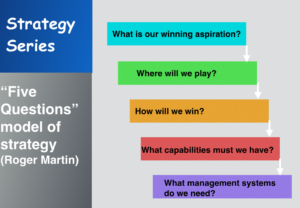I am doubling down on the critical role of real strategy for schools.
I have read a lot of school strategic plans, and most share one thing in common: they are not strategic at all. They are almost all tactical.
Strategy is, simply, about making choices that gives your school or district the best opportunity to thrive in the future. That’s where we have to start; all the rest will come later. But first we have to wrap our thinking around this very basic concept: strategy is the framework that gives your school the best chance to still be here twenty years from now.
 Going forward, if a school or district asks me to help them with a new strategic plan or vision, we will use the simplest, time-proven framework of real strategy: Lafley and Martin’s Five Questions model:
Going forward, if a school or district asks me to help them with a new strategic plan or vision, we will use the simplest, time-proven framework of real strategy: Lafley and Martin’s Five Questions model:
- What is our winning aspiration? What is it that will set your school apart from other learning options for families? Is it truly aspirational; will it excite people to rally to your flag? (Educators sometimes shy away from the term “winning” in this context, but it merely means surviving or thriving in the future.)
- Where will we play? What is your market; who are the families you are trying to attract? Where do they live and what other options do they have? Every market place is unique and knowing the market, what Sun Tzu calls “knowing the ground”, is critical to developing winning strategies.
- How will we win? What will your school do better than others who are “playing” in the same market? Why will it be better in the eyes of your stakeholders? How will you clearly differentiate your services and outcomes?
- What capabilities must we have to win? How will you actually deliver on your aspirational promise? How will you align pedagogy, curriculum, time and space, professional learning, class offerings, communication, and human resources in clear, direct support of your aspirational vision?
- What management systems do we need in order to ensure effective implementation of our strategy and tactics? How will you measure effectiveness to know if you actually are winning?
A good strategic plan, or what I hope will become a process of strategic design, should focus on generating answers and ongoing iterations to these five questions. A good plan can have just these five major headings. Every major goal of a good plan will clearly tie back to answering one of these questions.
The rest is tactics; tactics sit underneath one of these headings and are the ways you will implement these strategies. Tactics are critical, but they are NOT strategies. This is NOT a chicken-and-egg problem where we can reasonably argue which comes first. It is a cart-and-horse problem where the order is clear!











Leave A Comment